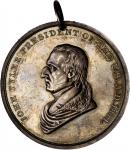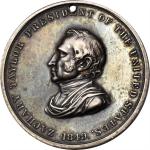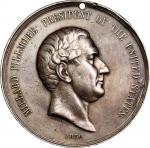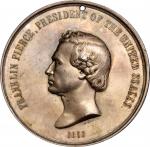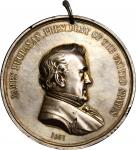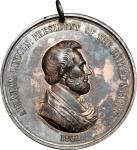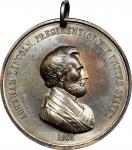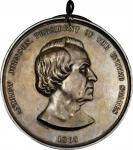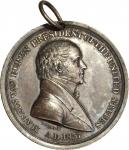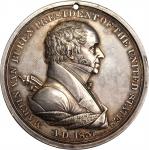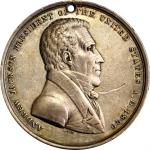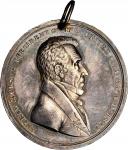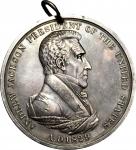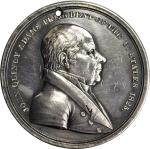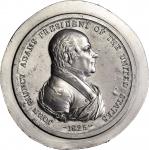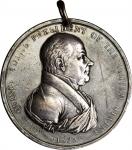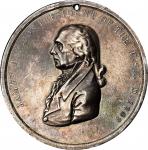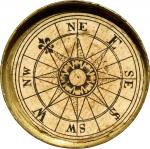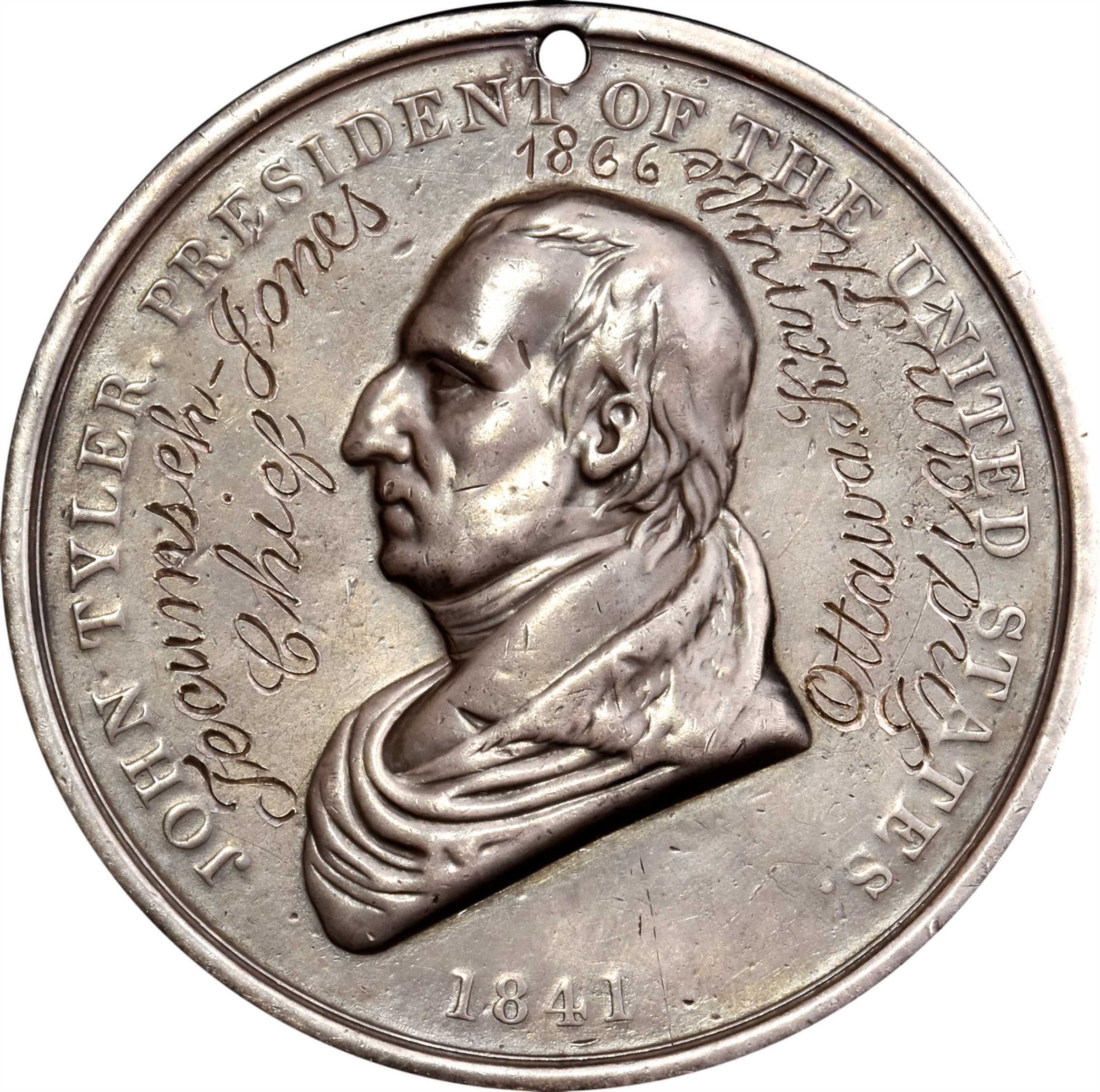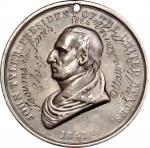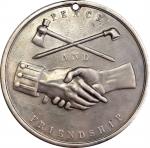1841 John Tyler Indian Peace Medal. Silver. First Size. First Reverse. Julian IP-21, Prucha-45. Very Fine. 75.2 mm. 2506.1 grains. Pierced at 12:00 for suspension, as typical, and positioned exactly as seen on each of the few confirmed genuine specimens. Fairly uniform deep gray patina over both sides with just a few areas of slightly lighter or darker tone. Well handled, but mostly with just smooth, even wear. Only close study under magnification will reveal the extent of fine abrasions and marks distributed over both sides. <p> <p>All John Tyler medals in silver are elusive, but the first size is the rarest, and most collectors will only have the chance to own a bronze. We have confirmed three distinct specimens, and suspect a fourth, though we have yet to verify it with with photographic evidence. Whether three or four are known means little, as this is the only example in private hands. The Chris Schenkel specimen, last sold in 1990, was gifted to the National Portrait Gallery at the Smithsonian, while the superb Andrew Zabriskie-W.W.C. Wilson medal is at the ANS. <p> <p>It is believed that 60 large-size medals were produced, but a significant percentage of all silver Tylers were returned to the mint, undistributed, and melted. The original estimate was for 60 large, and 200 of the smaller sizes, probably combined, as the current known populations of the second and third size medals are each just a little larger than what we see for the first-size ones. <p><strong> </strong><p><strong>The Inscription to John Tecumseh Jones</strong><p> <p>This piece is hand-engraved in the obverse fields as follows, TECUMSEH-JONES / CHIEF at left, 1866 at the top, and OTTAWA KANS. / INDIAN TRIBE at the right. The engraving seems to have been laid down after the medal was worn.<p> <p>The inscription is to John Tecumseh Jones, also known as Tauy Jones, a shortened version of "Ottawa Jones," as he came to be known locally. He was a prominent figure in Ottawa, Kansas, and had a significant hand in the citys foundation. Jones was born in Canada sometime between 1800 and 1809 (accounts vary, though his grave marker states 1800). Accounts also differ on his background. One identified him as Chippewa, educated in the state of Michigan at a Baptist mission, and later at Madison University, in New Jersey. Another account gives his primary education at Hamilton, New York, and then later at the Choctaw Academy in Kentucky. One intriguing account states that he was employed by the government to aid relocated Native peoples in their settlement of what would become Kansas. He is said to have moved to the area that would become Kansas Territory in the late 1830s, where he joined up with another prominent Baptist missionary, Rev. Jotham Meeker (who is credited with having brought Kansas its first printing press). Jones lived amongst the Ottawa and is said to have been formally recognized as Ottawa. He built a sizable home in the area, a promising location for future development, situated between the established locations of Forts Leavenworth and Scott. It is unclear what work allowed him the wealth he seems to have had, but the mention of him being "hired by the government" might explain his apparent comfort, and this medal.<p> <p>Jones was a supporter of Kansas as a Free Territory and corresponded with the famous John Brown, encouraging his abolitionist cause. One account, from the 1890s, describes their relationship as "very intimate" suggesting that their friendship and cooperation on abolitionist matters was likely well known locally. Their associations attracted undesirable attentions from Missouri, and a mob reportedly seeking the capture of Brown burned the Jones house in 1856. Successful and undeterred, he built a second house, also reported burned, and in 1862 a third, which stands today. <p> <p>The Ottawas signed a treaty with the Lincoln administration, dated June 24, 1862, that provided for American citizenship of all Ottawas and formal disbanding of the tribe, five years after ratification. In exchange, land grants were specified for the individual families and the community as a whole. Part of this agreement set aside land specifically for the establishment of a local school, and further land for a Baptist church. It also allowed for white settlers to purchase available lands in the area at a specified minimum price, with the clearly stated purpose of insuring "as far as possible, the settlement of their [the Ottawas] reservation by industrious whites, whose example shall be of benefit to the tribe at large." John Tecumseh Jones was the translator for the treaty proceedings and a signatory as a tribal Councilman. He was a respected agent from both sides.<p> <p>This Treaty set the Ottawa on a course for integration into the United States in a manner recognizable to white settlers. In the July 3, 1866, edition of the <em>Western Home Journal </em>of Ottawa, Kansas, a long article appeared that praised the town of Ottawa and recognized its then recent founding and the Christian principles that governed it. It discussed that, as of 1864, there was no town of Ottawa, and that by the time of publishing, it was a community that had grown to 1,200 residents. The foundation of the school specified in the Treaty was also mentioned, stating that many residents were "inspired by a laudable desire to provide for the education of their children" and that they had granted "twenty thousand acres of their lands to a Board of Trustees, four of whom are Indians, and all of whom are Baptists, the proceeds of which are to be used sacredly in the accomplishment of this object." It continues to read that "the plan admits and contemplates the founding of a university for the education of all classes of persons in every department of learning." Special mention was also made of "great credit" being due to John T. Jones, "an Indian chief and Baptist preacher," and two others for their work toward the success of the community. <p> <p>Ottawa University places its founding in 1865, and the same is true of the town of Ottawa, though its formal incorporation was in 1866. Clearly, enough white settlement had occurred by this time to warrant such formal organization, and the 1866 newspaper account referenced above speaks to that. John T. Jones, being a signatory and translator for the Treaty proceedings, as well as an influential local Baptist preacher, is credited to this day as a founder of the University, a fact engraved upon his tombstone in the Ottawa Indian Mission Burying Ground. As the founding of the university and town are inextricably linked through the Treaty of 1862, he was also central to the towns formation.<p> <p>It is clear that Jones was an early and influential inhabitant of what would become the town of Ottawa, but the details relating to the engraving and presentation of this Tyler medal remain uncertain. If Jones was indeed hired by the United States government to ease the transition and establishment of relocated Native Americans, it would have been useful to confer upon him some immediate status recognizable among the local people. As this would likely have been in the 1840s, it stands to reason that this Tyler medal might in fact have been given to him directly as part of his arrangements with the government. However, we have seen only a single account mentioning such an association. This said, there is reason to believe that Tyler medals might not have been only distributed at major treaty signings. Prucha includes two contemporary quotes relating to Tyler medals that suggest this. T. Hartley Crawford, the commissioner of Indian affairs, complained in 1842 "that this office has waited with some anxiety for a supply of medals, for occasional distribution…" and later in the year, Crawford wrote again that "occasions constantly occur in which the medals are required." It may not be possible to illustrate with certainty that Jones received a Tyler medal for perceived helpful deeds, but it is an intriguing possibility. If it was already his medal, the inscription could be a personal marker of achievement added at his request. If he was not the original recipient in the 1840s, then this piece was probably a private gift, presented to him to mark the formal incorporation of Ottawa, in 1866. As a related aside, most likely, he would have formally received a Lincoln Peace medal for the Treaty of 1862 signing.<p> <p>While the backstory of the medal is uncertain, the inscription was cut into the obverse less than 25 years after it was struck, so it was probably not too far removed from its original owner, whoever that may have been. While we have been able to piece together some valuable context for this important rarity, there is still much to be discovered!<p> <p>Perhaps most relevant to this offering is the rarity of the medal in general. As noted above, the first-size John Tyler in silver is among the rarest issues of the entire United States Peace medal series. This example is unique in private hands. For completion of the series, it is an essential acquisition. <p><strong> </strong> <em>From the E Pluribus Unum Collection. Earlier from the Charles P. Senter Collection, Anderson Galleries (Wayte Raymond), October 1933, lot 67; Charles H. Fisher, March 1936, lot </em><em>763; F.C.C. Boyd; </em><em>John J. Ford, Jr.; our (Stacks) sale of the John J. Ford, Jr. Collection, Part XVI, October 2006, lot 136.</em><em></em>

